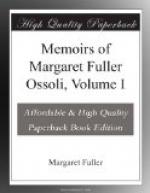some had felt it was merely perception; others
apprehended it as influx upon the soul from the
soul-side of its being. Then she spoke of the
conversation upon poesy as the ground of all the fine
arts, and also of the true art of life; it being
not merely truth, not merely good, but the beauty
which integrates both. On this poesy, she
dwelt long, aiming to show how life,—perfect
life,—could be the only perfect manifestation
of it. Then she spoke of the individual as
surrounded, however, by prose,—so
we may here call the manifestation of the temporary,
in opposition to the eternal, always trenching on
it, and circumscribing and darkening. She spoke
of the acceptance of this limitation, but it should
be called by the right name, and always measured;
and we should inwardly cling to the truth that
poesy was the natural life of the soul; and never
yield inwardly to the common notion that poesy was
a luxury, out of the common track; but maintain
in word and life that prose carried the soul out
of its track; and then, perhaps, it would not
injure us to walk in these by-paths, when forced
thither. She admitted that prose was the necessary
human condition, and quickened our life indirectly
by necessitating a conscious demand on the source
of life. In reply to a remark I made, she
very strongly stated the difference between a
poetic and a dilettante life, and sympathized
with the sensible people who were tired of hearing
all the young ladies of Boston sighing like furnace
after being beautiful. Beauty was something
very different from prettiness, and a microscopic
vision missed the grand whole. The fine arts
were our compensation for not being able to live out
our poesy, amid the conflicting and disturbing forces
of this moral world in which we are. In sculpture,
the heights to which our being comes are represented;
and its nature is such as to allow us to leave
out all that vulgarizes,—all that bridges
over to the actual from the ideal. She dwelt long
upon sculpture, which seems her favorite art.
That was grand, when a man first thought to engrave
his idea of man upon a stone, the most unyielding
and material of materials,—the backbone
of this phenomenal earth,—and, when
he did not succeed, that he persevered; and so,
at last, by repeated efforts, the Apollo came
to be.
“But, no; music she thought the greatest of arts,—expressing what was most interior,—what was too fine to be put into any material grosser than air; conveying from soul to soul the most secret motions of feeling and thought. This was the only fine art which might be thought to be nourishing now. The others had had their day. This was advancing upon a higher intellectual ground.
“Of painting she spoke, but not so well. She seemed to think painting worked more by illusion than sculpture. It involved more prose, from its representing more objects. She said nothing adequate about color.
“She dwelt upon the
histrionic art as the most complete, its
organ being the most flexible
and powerful.




